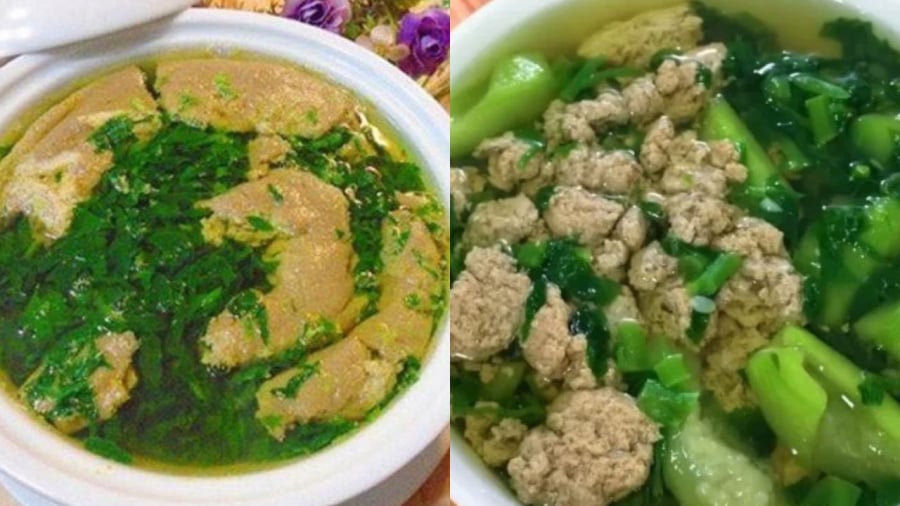Crab soup is a humble yet delicious dish in Vietnamese cuisine. During the summer, it is a common sight to see crab soup served at mealtimes.
However, to prepare a tasty bowl of crab soup with abundant floating meat chunks and a clear, non-fishy broth, one needs the expertise of a skilled home cook.
Tips for Selecting the Best Crabs
Wild-caught crabs differ from farmed ones as their meat is more fragrant and less fishy. To distinguish between the two, pay attention to the seller. Farmed crabs are usually sold in large, uniform batches, while truly wild-caught crabs are sold in smaller quantities as they are harder to catch in large numbers.
When choosing crabs, opt for female crabs with larger aprons, as they will yield a richer, more savory broth. Male crabs, on the other hand, have firmer meat but lack the same level of richness.

Look for crabs that have all their legs and claws intact, are active and firm to the touch. Avoid crabs with damaged or foamy aprons, as these are signs of poor quality or dying crabs. Larger crabs are preferable, as smaller ones tend to have less meat, resulting in fewer floating meat chunks in the soup. Steer clear of female crabs carrying eggs, as they tend to be thinner during their reproductive phase.
It is also worth noting that crabs grow according to the lunar cycle. For the best flavor, purchase crabs at the beginning or end of the lunar month, as crabs in the middle of the month tend to molt, making them thinner and less meaty.
Steps to Prepare a Sweet and Delicious Crab Soup with Clear Broth and Floating Meat Chunks
Step 1: Start by cleaning the crabs: Proper cleaning ensures that the crabs don’t taste fishy or dirty. Place the crabs in a container and vigorously rinse them to remove any dirt. Pull apart the crab shells, and then wash away the black liquid inside the body, as this liquid is the main source of the fishy odor.
Step 2: Puree the crabs: Place the bodies and claws in a blender or food processor to puree. Alternatively, you can use a traditional mortar and pestle. If using a blender, you will be able to extract more meat. However, the traditional method of pounding yields a unique flavor.
Note: While blending or pounding the crabs, add a small amount of salt. If you ask the seller to process the crabs, don’t forget to remind them to add salt, as they may forget. Salt helps the protein in the crab meat congeal, resulting in more floating meat chunks and a clearer broth. Transfer the pureed crab to a large bowl, add water, stir, and then strain the mixture.

As for the crab shells, use a hard object like a toothpick or fork to extract the crab roe, and then rinse it through a sieve to remove the black liquid.
Step 3: Cook the crab broth: Place the strained crab liquid in a pot over the stove and stir in one direction with a pair of chopsticks while cooking. Maintain a moderate heat level—not too high or too low—to ensure the meat chunks float. If you want more meat chunks, you can beat an egg into the broth before cooking.
Once the meat chunks start floating, remove them with a ladle and set them aside. Only then should you add the vegetables to the broth. This step ensures that the meat chunks remain tender and soft, as prolonged cooking will make them tough and less palatable.
The best vegetables to use in crab soup are spinach, water mimosa, water spinach, or green amaranth. After adding the vegetables, skim off any foam that forms on the surface, and season the soup to taste.
There are two methods for preparing the crab roe: If you prefer a richer, more aromatic soup, fry the roe with sautéed shallots. Then, pour this mixture over the meat chunks that were previously removed from the broth. Ladle the vegetable soup into bowls, and top with the seasoned meat chunks.
The second method involves adding the roe directly to the broth once the meat chunks have started floating. This approach creates a more visually appealing dish, as the yellow roe adds a pop of color to the meat chunks. If you’re in a hurry, you can simply add the roe directly to the pot while cooking.
3 Delicious Summer Family Meals to Impress
The summer heat can be a challenge for any home cook, but it’s also an opportunity to get creative and keep your family’s taste buds tantalized. We’ve got three delicious family meal ideas for the summer that will impress and satisfy your loved ones. It’s time to showcase your culinary skills and keep your family cool and content this season!
From Country Fence to City Feast: The Wild Hibiscus Flower’s Gourmet Transformation
In an era of fusion cuisine, there’s a growing appetite for simple, rustic dishes that evoke childhood memories. The leaves and young shoots of the hibiscus plant, once a common sight along fences, are now sought-after delicacies in online markets, fetching prices as high as 50,000 VND per kilogram.






































